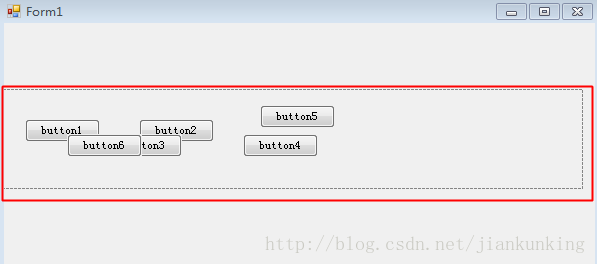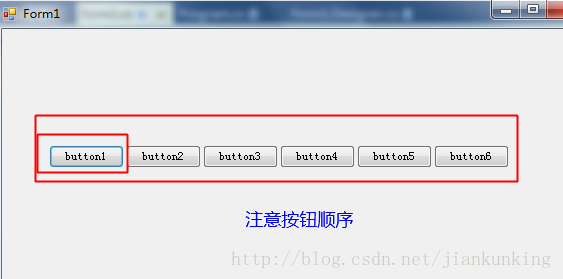Winform Panel button location
1. Set a button to be centered on the Panel
this.btnExit.Location = new System.Drawing.Point(pnlButton.Width / 2, pnlButton.Height / 2);
2. Automatically sort multiple buttons on the Panel
Original state:

Code for adjusting the order:
/// <summary>
/// 设置按钮显示位置
/// </summary>
/// <param name="targetPanel">要设置按钮的Panel</param>
/// <param name="buttonSpace">按钮之间的间隔</param>
public void SetButtonCenter(Panel targetPanel, int buttonSpace)
{
int length = 0;
List<Button> listBtn = new List<Button>();
System.Windows.Forms.Control.ControlCollection c = targetPanel.Controls;
foreach (Button btn in c)
{
listBtn.Add(btn);
length += btn.Width + buttonSpace;
}
int pnlLength = targetPanel.Width;
if (length > pnlLength) //本身按钮的长度总和大于了panel的长度,不调整
return;
int startPos = (pnlLength - length) / 2 - 10; //左缩进10个点位
int yPos = targetPanel.Height / 2;
int xPos = startPos;
foreach (Button btn in listBtn)
{
btn.Location = new System.Drawing.Point(xPos, yPos);
xPos += btn.Width + buttonSpace;
}
}Preliminary adjustment appearance:

Note that the button order is reversed!
So how to make the button order correct?
The code is as follows:
private void Form1_Load(object sender, EventArgs e)
{
SetButtonCenter(panelTest, 2);
}
/// <summary>
/// 设置按钮显示位置
/// </summary>
/// <param name="pnlButton">需要调整按钮顺序的Panel</param>
/// <param name="buttonSpace">按钮间隔</param>
public void SetButtonCenter(Panel targetPanel,int buttonSpace)
{
int length = 0;
List<Button> listBtn = new List<Button>();
System.Windows.Forms.Control.ControlCollection c = targetPanel.Controls;
foreach (Button btn in c)
{
listBtn.Add(btn);
length += btn.Width + buttonSpace;
}
int pnlLength = targetPanel.Width;
if (length > pnlLength) //本身按钮的长度总和大于了panel的长度,不调整
return;
int startPos = (pnlLength - length) / 2 - 10; //左缩进10个点位
int yPos = targetPanel.Height / 2;
int xPos = startPos;
listBtn.Sort(new ButtonSort());
foreach (Button btn in listBtn)
{
btn.Location = new System.Drawing.Point(xPos, yPos);
xPos += btn.Width + buttonSpace;
}
}
public class ButtonSort : IComparer<Button>
{
#region IComparer<Button> Members
//IComparer<T> 接口:定义类型为比较两个对象而实现的方法。
public int Compare(Button x, Button y)
{
if (x.TabIndex >= y.TabIndex)
return 1;
else
return -1;
}
#endregion
}The effect at this time is as follows:

Expansion: Click to open the link
The above is the content of the Winform Panel button location. For more related content, please pay attention to the PHP Chinese website (www.php.cn)!

Hot AI Tools

Undresser.AI Undress
AI-powered app for creating realistic nude photos

AI Clothes Remover
Online AI tool for removing clothes from photos.

Undress AI Tool
Undress images for free

Clothoff.io
AI clothes remover

AI Hentai Generator
Generate AI Hentai for free.

Hot Article

Hot Tools

Notepad++7.3.1
Easy-to-use and free code editor

SublimeText3 Chinese version
Chinese version, very easy to use

Zend Studio 13.0.1
Powerful PHP integrated development environment

Dreamweaver CS6
Visual web development tools

SublimeText3 Mac version
God-level code editing software (SublimeText3)

Hot Topics
 How to use char array in C language
Apr 03, 2025 pm 03:24 PM
How to use char array in C language
Apr 03, 2025 pm 03:24 PM
The char array stores character sequences in C language and is declared as char array_name[size]. The access element is passed through the subscript operator, and the element ends with the null terminator '\0', which represents the end point of the string. The C language provides a variety of string manipulation functions, such as strlen(), strcpy(), strcat() and strcmp().
 .NET Deep Dive: Mastering Asynchronous Programming, LINQ, and EF Core
Mar 31, 2025 pm 04:07 PM
.NET Deep Dive: Mastering Asynchronous Programming, LINQ, and EF Core
Mar 31, 2025 pm 04:07 PM
The core concepts of .NET asynchronous programming, LINQ and EFCore are: 1. Asynchronous programming improves application responsiveness through async and await; 2. LINQ simplifies data query through unified syntax; 3. EFCore simplifies database operations through ORM.
 How to use various symbols in C language
Apr 03, 2025 pm 04:48 PM
How to use various symbols in C language
Apr 03, 2025 pm 04:48 PM
The usage methods of symbols in C language cover arithmetic, assignment, conditions, logic, bit operators, etc. Arithmetic operators are used for basic mathematical operations, assignment operators are used for assignment and addition, subtraction, multiplication and division assignment, condition operators are used for different operations according to conditions, logical operators are used for logical operations, bit operators are used for bit-level operations, and special constants are used to represent null pointers, end-of-file markers, and non-numeric values.
 What is the role of char in C strings
Apr 03, 2025 pm 03:15 PM
What is the role of char in C strings
Apr 03, 2025 pm 03:15 PM
In C, the char type is used in strings: 1. Store a single character; 2. Use an array to represent a string and end with a null terminator; 3. Operate through a string operation function; 4. Read or output a string from the keyboard.
 Avoid errors caused by default in C switch statements
Apr 03, 2025 pm 03:45 PM
Avoid errors caused by default in C switch statements
Apr 03, 2025 pm 03:45 PM
A strategy to avoid errors caused by default in C switch statements: use enums instead of constants, limiting the value of the case statement to a valid member of the enum. Use fallthrough in the last case statement to let the program continue to execute the following code. For switch statements without fallthrough, always add a default statement for error handling or provide default behavior.
 What is the function of C language sum?
Apr 03, 2025 pm 02:21 PM
What is the function of C language sum?
Apr 03, 2025 pm 02:21 PM
There is no built-in sum function in C language, so it needs to be written by yourself. Sum can be achieved by traversing the array and accumulating elements: Loop version: Sum is calculated using for loop and array length. Pointer version: Use pointers to point to array elements, and efficient summing is achieved through self-increment pointers. Dynamically allocate array version: Dynamically allocate arrays and manage memory yourself, ensuring that allocated memory is freed to prevent memory leaks.
 How to handle special characters in C language
Apr 03, 2025 pm 03:18 PM
How to handle special characters in C language
Apr 03, 2025 pm 03:18 PM
In C language, special characters are processed through escape sequences, such as: \n represents line breaks. \t means tab character. Use escape sequences or character constants to represent special characters, such as char c = '\n'. Note that the backslash needs to be escaped twice. Different platforms and compilers may have different escape sequences, please consult the documentation.
 How to convert char in C language
Apr 03, 2025 pm 03:21 PM
How to convert char in C language
Apr 03, 2025 pm 03:21 PM
In C language, char type conversion can be directly converted to another type by: casting: using casting characters. Automatic type conversion: When one type of data can accommodate another type of value, the compiler automatically converts it.






